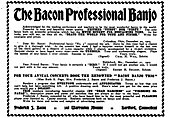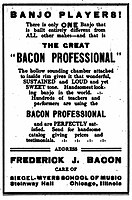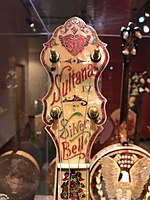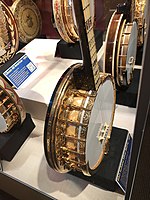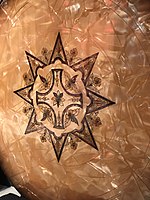The banjo is a stringed instrument with a thin membrane stretched over a frame or cavity to form a resonator. The membrane is typically circular, in modern forms usually made of plastic, originally of animal skin. Early forms of the instrument were fashioned by African Americans and had African antecedents. In the 19th century, interest in the instrument was spread across the United States and United Kingdom by traveling shows of the 19th century minstrel show fad, followed by mass-production and mail-order sales, including instruction method books. The inexpensive or home-made banjo remained part of rural folk culture, but 5-string and 4-string banjos also became popular for home parlor music entertainment, college music clubs, and early 20th century jazz bands. By the early 21st century, the banjo was most frequently associated with folk, bluegrass and country music, but was also used in some rock, pop and even hip-hop music. Among rock bands, the Eagles, Led Zeppelin, and the Grateful Dead have used the five-string banjo in some of their songs. Some famous pickers of the banjo are Ralph Stanley and Earl Scruggs.

A clef is a musical symbol used to indicate which notes are represented by the lines and spaces on a musical staff. Placing a clef on a staff assigns a particular pitch to one of the five lines or four spaces, which defines the pitches on the remaining lines and spaces.
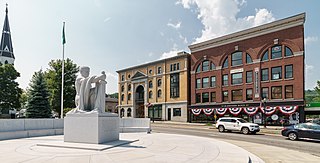
Barre is the most populous city in Washington County, Vermont, United States. As of the 2020 census, the municipal population was 8,491. Popularly referred to as "Barre City", it is almost completely surrounded by "Barre Town", which is a separate municipality.

The American Legion, commonly known as the Legion, is a patriotic organization of U.S. war veterans headquartered in Indianapolis, Indiana. It comprises state, U.S. territory, and overseas departments, in turn, made up of local posts. It was established in March 1919 at Paris, France, by officers and men of the American Expeditionary Forces (A.E.F.). In September 1919, it was chartered by the U.S. Congress.

James Hartness was an American business executive, inventor, mechanical engineer, entrepreneur, amateur astronomer, and politician who served as the 58th governor of Vermont from 1921 to 1923.
Frederick J. Moynihan was an American sculptor, born on the Isle of Guernsey in 1843. He died in his New York City studio on January 9, 1910.

Stanley Calef Wilson was an American politician, attorney, and businessman from Vermont. He served as the 57th lieutenant governor of Vermont from 1929 to 1931 and the 62nd governor of Vermont from 1931 to 1935.
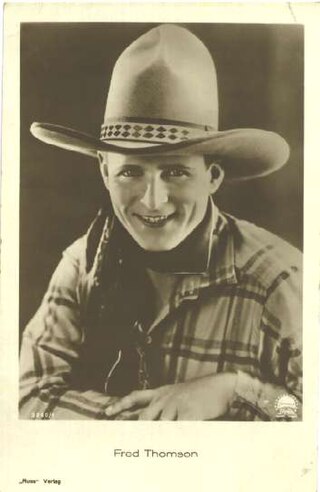
Frederick Clifton Thomson was an American silent film cowboy who rivaled Tom Mix in popularity before dying at age 38 of tetanus.

Hungarian Rhapsody No. 2 in C-sharp minor, S.244/2, is the second in a set of 19 Hungarian Rhapsodies by composer Franz Liszt, published in 1851, and is by far the most famous of the set.
Frederick J. Jackson, also known professionally as Fred Jackson and Frederick Jackson and under the pseudonym Victor Thorne, was an American author, playwright, screenwriter, novelist, and producer for both stage and film. A prolific writer of short stories and serialized novels, most of his non-theatre works were published in pulp magazines such as Detective Story Magazine and Argosy. Many of these stories were adapted into films by other writers.

Fred Van Eps was an American banjoist and banjo maker. The "Van Eps Recording Banjo" was a well-known model until 1930. He was the father of jazz guitarist George Van Eps.
Hans Heinrich Bürmann was a German mathematician and teacher. He ran an "academy of commerce" in Mannheim since 1795 where he used to teach mathematics. He also served as a censor in Mannheim. He was nominated Headmaster of the Commerce Academy of the Grand Duchy of Baden in 1811. He did scientific research in the area of combinatorics and he contributed to the development of the symbolic language of mathematics. He discovered the generalized form of the Lagrange inversion theorem. He corresponded and published with Joseph Louis Lagrange and Carl Hindenburg.

The American Banjo Museum Hall of Fame, formerly known as the National Four-String Banjo Hall of Fame, recognizes musicians. bands, or companies that have made a distinct contribution to banjo performance, education, manufacturing, and towards promotion of the banjo. The hall of fame is a part of the American Banjo Museum located in Oklahoma City, Oklahoma.

Clarence Lockhart Partee was an American composer and arranger and music publisher. He was also founder, editor and publisher of The Cadenza magazine, and devoted his life to teaching and advancing the banjo, mandolin and guitar, arranging more than 150 works for these three instruments. He was a charter member of the American Guild of Banjoists, Mandolinists & Guitarists, now two separate organizations, the American Guild of Music and the Fretted Instrument Guild of America .

William Foden was an American composer, musician, and teacher. Foden is considered America's premiere classical guitarist during the 1890s and the first decades of the twentieth century.
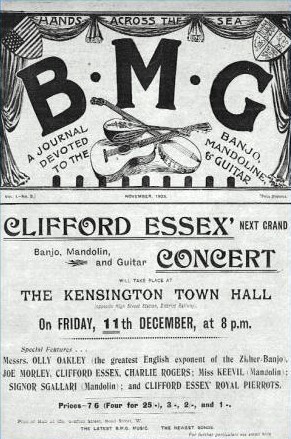
The Banjo, Mandolin and Guitar (BMG) movement is a music genre based on the family of fretted stringed instruments played with a plectrum or fingers, with or without fingerpicks. The instruments include the banjo, mandolin and guitar. This became popular in the US in the late 19th century and into the 20th century. It fell from favour in the 1930s but there is still an organised movement in the UK where the BMG, founded in 1903, is the country's oldest music periodical still publishing. In the United States, a major magazine for the movement was The Cadenza magazine, published by Clarence L. Partee.
Forest Dale is an unincorporated village in the town of Brandon, Rutland County, Vermont, United States. The community is located at the intersection of Vermont Route 53 and Vermont Route 73 15.5 miles (24.9 km) north of Rutland. Forest Dale has a post office with ZIP code 05733.
Stanley J. Damerell was, in his early life, a British vaudevillian actor, writer, and producer, and in his later life, a prolific lyricist, and, to a lesser degree, composer of popular songs.







